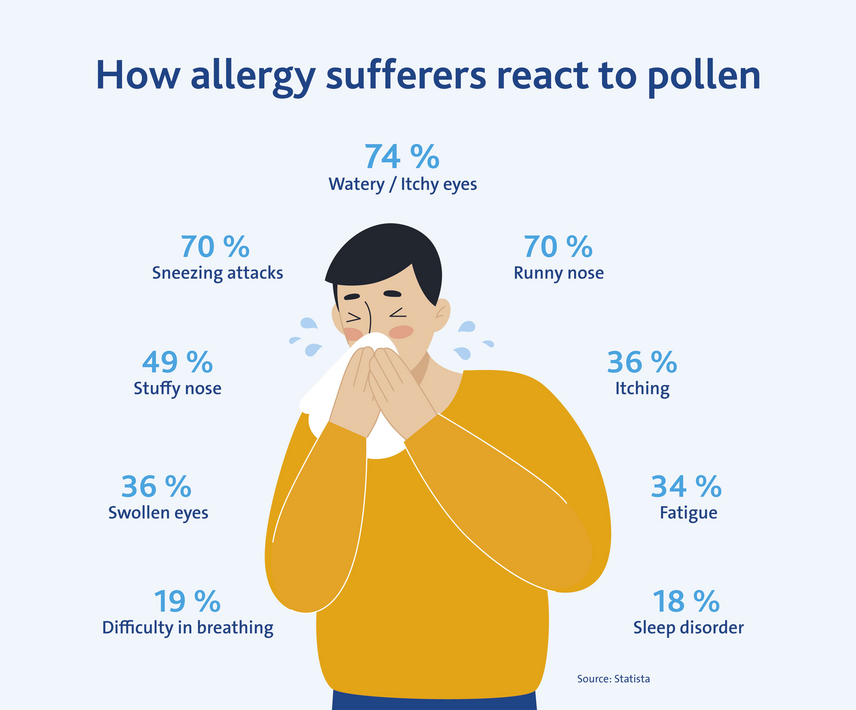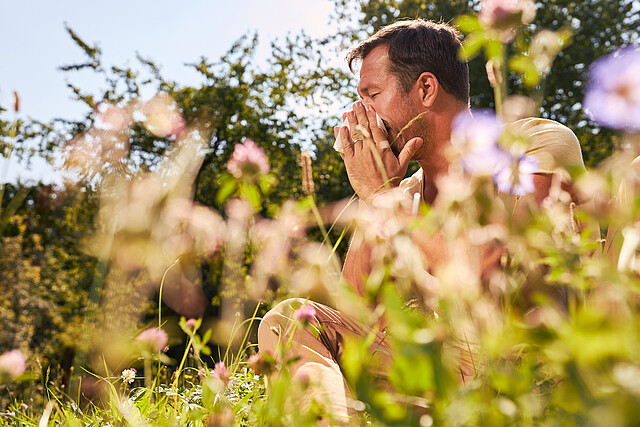I react therefore I am allergic?
What triggers allergies and how we can effectively protect ourselves from them
It’s that time of year again: the peak season for pollen allergy sufferers in the northern hemisphere begins in March, if not before. Early bloomers like hazel and alder are joined on a daily basis by others, such as birch, beech, and a wide variety of grasses. The pollen count begins to increase, filling the air with more and more allergens. As a result, many people around the world struggle with runny noses, coughs, sneezing attacks, and reduced well-being. But what exactly are allergens? How are allergies triggered? How can we reliably protect ourselves? And why on earth do we react to something that is constantly around us?

What are allergies?
An allergic reaction is a defensive reaction by the immune system to substances that are foreign to the human body but in themselves harmless. Around 20,000 allergens have now been identified. Although most allergens are proteins with a widespread presence in the environment, they do not have much in common with one another. Once the human body comes into contact with them, the immune system may mistakenly classify them as dangerous and try to fight them with an autoimmune response. This results in a runny nose, coughing, red or swollen skin, watery eyes, and fatigue.
The most common allergy is a pollen allergy. Pollen is generally very useful, as it is responsible for pollination and is consequently a central component of plant reproduction. A wide variety of allergens other than pollen can also trigger unpleasant reactions.

Cross-allergies — a special case: People who suffer from an allergy to birch pollen, for example, may also have an allergic reaction if they eat apples or pears. This is due to similarities between segments of molecules in the respective allergens. As a result, the immune system acts in a similar manner. It is a case of mistaken identity, so to speak.
Have we always been allergic to birch, grasses, and mugwort?
There is historical evidence that people suffered from allergic reactions as early as Ancient Egypt and the Roman Empire. However, it was only in 1819 that an English physician gave a detailed description of hay fever as one of the most common allergic reactions.
Prior to that, there was only isolated scientific documentation of the course of diseases that correspond to our current understanding of hay fever, such as sixteenth century descriptions of the “rose cold”.
The number of allergy sufferers is increasing
It is said that around one third of the world’s population now suffers from allergies. Most of those affected suffer from hay fever. The proportion of allergy sufferers has risen continuously over the past decades, but it is not easy to explain why. Several factors are likely to play a role, including our hygiene. In many countries, children in particular are exposed to far less dirt, germs, and pathogens than they were a hundred years ago. Parents are increasingly concerned with clean environments and children spend less and less time outdoors. However, such attempts to prevent disease can cause the immune system to become accustomed to fewer foreign substances.
Environmental pollution also influences the spread of allergies. One study has shown that birch pollen can attach itself to fine diesel soot and so the allergen can penetrate deeper into the lungs when inhaled. Another factor is the increased amount of pollen in the air due to climate change. The more allergens the body is exposed to on a daily basis, the stronger its reaction. There are examples of people who are now clearly aware of pollens to which they previously had such a minimal reaction, they often did not even notice they had an allergy.
Are hay fever and other allergies dangerous?
No one would claim that an allergy to wasp venom is harmless. The harm caused becomes obvious once the affected part of the body swells and the skin reddens after being stung. It is common knowledge that the consequences of a peanut allergy can also be life-threatening.
Hay fever, however, does not at first seem a cause for concern. People might think it’s just a few sniffles and sneezes. Far from it. In fact, almost 40 percent of all pollen allergy sufferers develop asthma during the course of their lives. This phenomenon is known as progression. The inflammatory processes progress from the nasal mucous membranes and upper airways to the lower ones, triggering allergic asthma, which in turn leads to a significant reduction in quality of life.
How can you protect yourself from airborne allergens?
Pollen allergy sufferers should protect themselves from airborne allergens in as many situations as possible to prevent allergic reactions and their consequences. The solution is dependent on the space in which the person is.
It is clear that allergies aren’t going away any time soon. Advancing climate change will increase the amount of pollen in the air, which will result in more people being affected by hay fever. But there is good news. In addition to a wealth of medications and therapies for alleviating symptoms, increasingly powerful air pollution control solutions are finding their way into our daily lives. These minimize allergen concentrations in the air, which is an important step for everybody’s health.
Learn more about the impact of climate change on allergy season in our online magazine “PURE – INDUSTRIAL FILTER MAGAZINE”.















